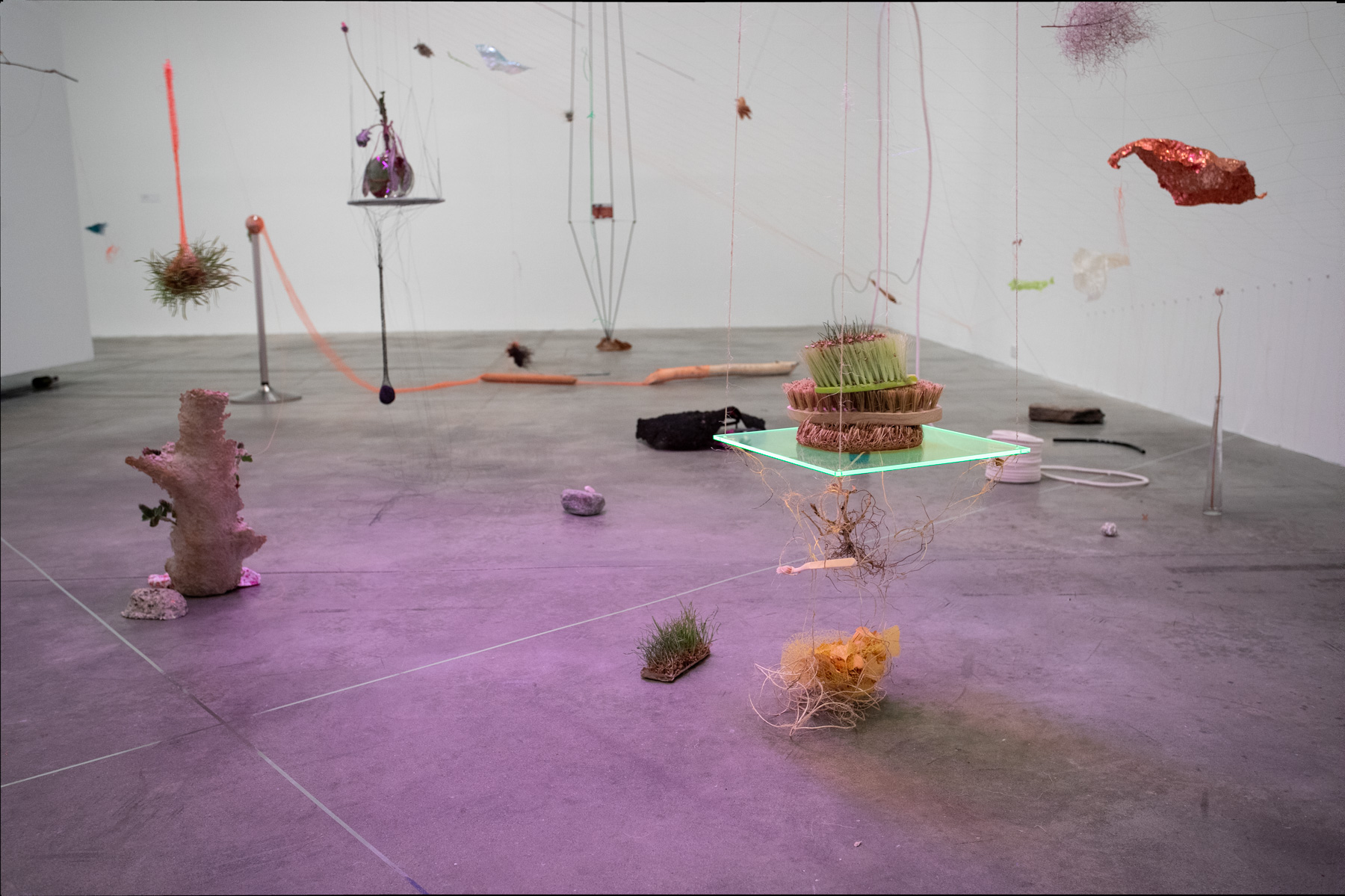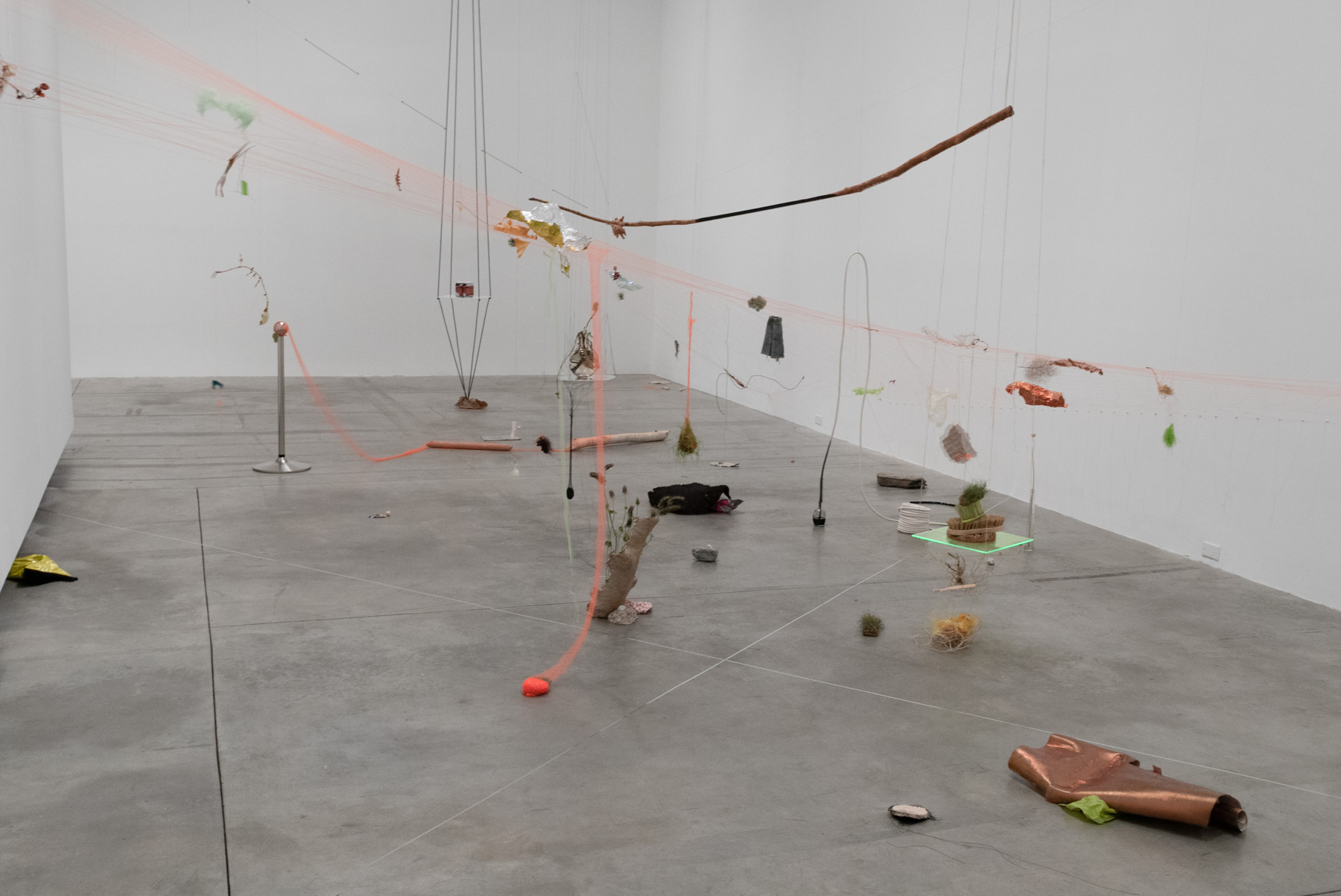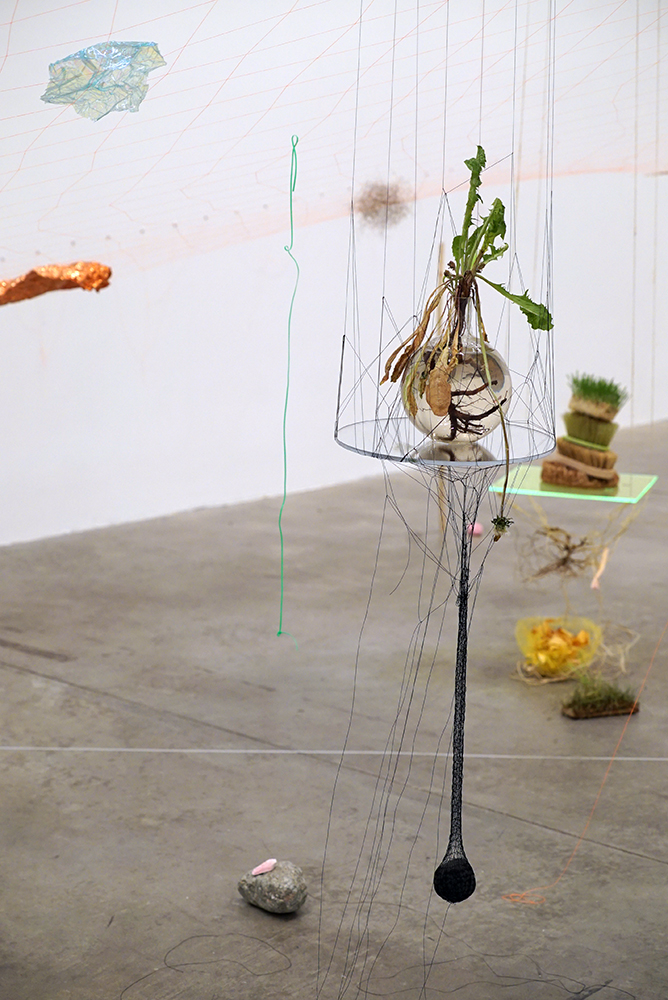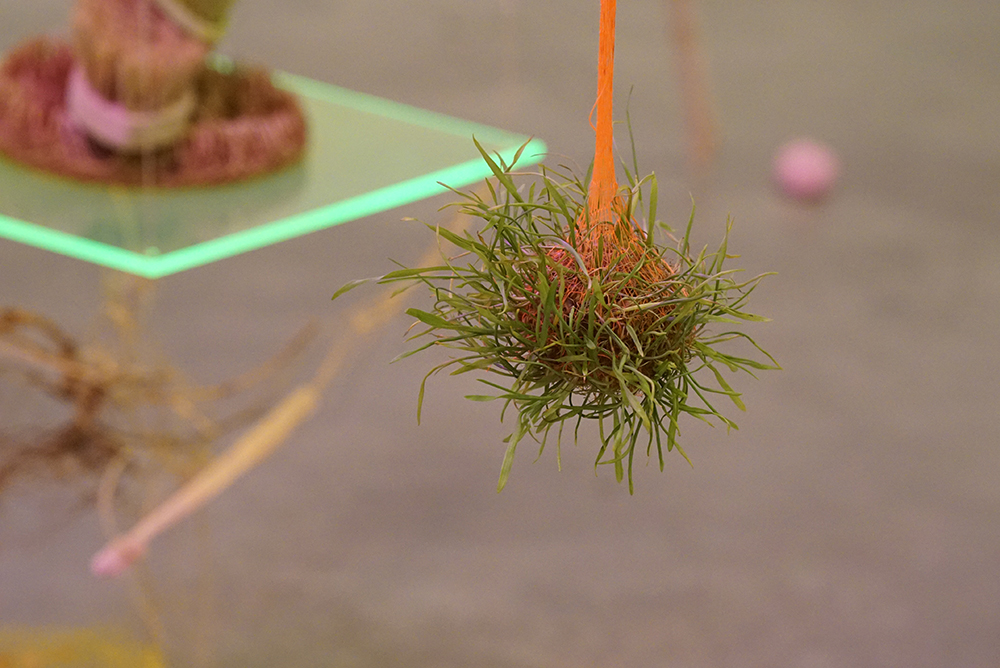Natalie Purschwitz



BIOMASS: Welcome Natalie! I am so glad to have the opportunity to discuss your work for Volume 2. I want to begin by talking about your project Unknown Variables. This work has so many different components and range, it functions both as a large-scale installation but also has a plethora of miniscule details. Could you describe the material and ideation process that went into this project?
Natalie Purschwitz: It may be good to start with a previous work, Stalagmites, because what I am doing now really evolved from that process.. I had been accumulating a lot in the studio and creating conditions for material collaborations, introducing materials to each other to see what might happen. I’m interested in how humans and non-humans shape the landscape. I was making inks from found and collected materials, like beet juice, acorns and sidewalk salt from melting snow. I was also thinking about dirt, earth and soil, and what all of those words mean and how they are different from each other. There were a lot of living elements in Stalagmites, things growing on packaging, bottle caps, candy wrappers and various discarded materials and what I hadn’t thought through, about the installation, was that I would have to go in and maintain these things every day, setting up and taking down a grow light, and misting and watering all of the tiny plants.. I noticed over time that this work started to look more and more like a diagram, like an equation with parentheses around different material collaborations. I started thinking more about space and lines – reading Doreen Massey’s, For Space, Tim Ingold’s Life of Lines, Kathleen Stuart’s Ordinary Affect and her notion of intraaction– and about what a diagram is and how that is different from a drawing for example. This is what led me to working on a diagram as an entry point for talking about my research ideas. But it kept falling apart. So it was more the unravelling of this diagram that led me to Unknown Variables.
B: So instead of creating work through a diagramatic plan, you seem to follow the work to whatever ends it produces itself. How would you describe your process throughline?
NP: One of the important developments for me was making a huge thread net. It was a very meditative process for me, something I figured out how to do and could maintain a certain level of control over and think about things while making it. The idea of a net, as a precarious support in one way and a system of control that catches things indiscriminately. It felt like a metaphor but was also very literal. Thinking of different forms of capture and communication. Like a spider’s web signals communication, it knows when it has caught its prey because it receives vibrations through the threads. I was also reading Fernand Deligny, who was a french critical theorist who started a commune for non-verbal autistic children, it's called the Arachnean – so very web oriented– and he talks about the network as a mode of being, this is pre-internet of course. Everything is interconnected, everything in the net affects everything else in the net, but they don’t necessarily have to be in a direct relationship with each other.
What I’ve come to determine is the way a drawing and diagram differ. A diagram indicates something that is known, whereas a drawing or points to something that is not yet known. So I guess I’ve been thinking about the net as an emergent diagram where things are constantly in a state of becoming known.
B: That makes me wonder if you define a difference between your daily life and art practice? Are there any boundaries?
NP: That is becoming a really challenging question! *Laughter*
B: Do you think it's necessary to have a separation?
NP: I don’t know, the way this whole year has unfolded… in some ways I feel like I’m just working all the time now. This endless unfolding of my life, which is my art practice. I think that was at first a necessary approach but now I'm wondering if there needs to be some separation. Part of the reason for that is everything this year has been online, which makes it hard to feel like it's real. My instinct is that it's all connected and all part of the same process.

Natalie Purschwitz. Unknown Variables. mixed media. 2021

Natalie Purschwitz. Unknown Variables. mixed media. 2021
B: The other side of that question is have you come across strategies or ways of working that have edited out things you find draining on your practice? Are there things about being an artist that you have decided to edit out of your practice?
NP: Yes, but I mean I have a hard time editing. The idea of editing is really appealing to me, but I’m not very good at it, so I always end up doing a bit too much. One thing I would say is that I need to say yes to fewer things, or invest in specific things rather than stretch myself too thin. More specifically I have a meditation practice, and that's something that has really helped me through all this, and thinking about making artwork as another meditation practice. What I need is something that will help alleviate the messiness of the daily grind.
B: As the maker of these immersive installations, what qualities do you enjoy most about immersive works?
NP: Making connections between things that are unexpected. Recognizing value in things that perhaps didn’t have value before. But also the experience of being reflected by the materials in the objects. I like to think of an installation as a kind of mirror that is activated by the viewer and in the process of attending the viewer learns something about themselves.
B: I liked your mention of the term “cognitive states”, I’m curious how you would describe productive cognitive states for you as a maker?
NP: I think, what I’m always trying to do, what I find productive is when I have some sort of moment of clarity, when something begins to become legible in some way. When it feels like a dynamic relationship is forming -I find that productive. It can be very hard to write or talk about these things because they are often experiential. I think it's when the cognitive and affective collapse together.

Natalie Purschwitz. Unknown Variables. mixed media. 2021
B: I think it's a specific language that artists have to understand, what it means to go through the lifecycle of making and sharing artwork. Where do you mark a beginning point of new work?
NP: I think that’s why the net has been a useful structure for me, in the process of making the net I felt like the answers came to me. It gave me a container to start with and add things to. The dismantling of it is a whole other thing. Taking the work apart and dealing with the stuff! A lot of it is compostable, luckily.
B: Yeah, what happens to all the stuff?
NP: I end up reusing a lot of things. There is a purple plastic candy wrapper that I really love, and that has made appearances in several installations. I’m constantly thinking of ways I can deal with stuff or think about it in a new way, or manage it without having to throw it away. I thought about making a free shrine, where people could take things or add even.
B: It sounds like proxy work, your practice seems almost inevitable.
NP: It does feel like that. I do have to be careful about keeping too much stuff. It kind of takes over my life a little. One thing I would also say that developed from the past couple exhibitions, is that I am thinking about making some works that are less dependent on me, to see what kinds of things could develop on their own. Because my installations evolve with elements being added and tended to daily, I feel like it would be good to step back and allow some space for things to become and change without me, let the drawing continue to draw itself.

Natalie Purschwitz. Unknown Variables. Detail. mixed media. 2021
Natalie Purschwitz is an artist living and working on the traditional, ancestral and unceded territories of the xwməθkwəy̓əm (Musqueam), Sḵwx̱wú7mesh (Squamish), and Selílwitulh (Tsleil-Waututh) people. Thinking about earth - as a complexity of materials a location, a temporal range, a perspective, an intelligence, a system within systems, a geometric configuration, an embodiment of motion and a life-supporting loam - has become the primary substance of her research. She draws from personal experience daily practice/observation, and theoretical discourse to coax out relational clusters of meaning, correspondences, and visual strands to form a matrix of interconnected nodes. Purschwitz has shown her work nationally and internationally at the Vancouver Art Gallery, The Polygon Gallery (North Vancouver, BC), Plug In ICA (Winnipeg, MB), the Japanese Canadian National Museum (Burnaby, BC), the McMichael Canadian Art Collection (Kleingburg, ON), the Prince Takamato Gallery (Tokyo, Japan), Canad House (London, UK) and AGX Galerie (Tehran, Iran).
